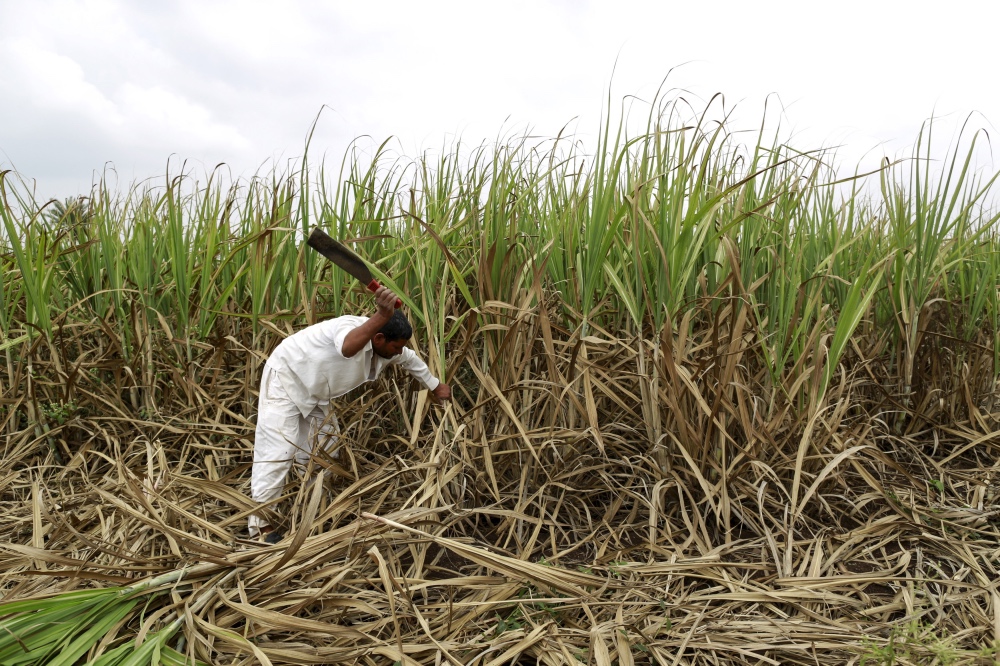Shillong, India
Thomson Reuters Foundation
Tribal people in north-eastern India are increasingly becoming landless and poor as their traditional farming practices are abandoned in favour of commercial plantations, Indigenous experts warned last week.
“Jhum” is the practice by tribal groups in the north-eastern states of rotating land use for temporary farming, resulting in parts of forest land cleared and cultivated to grow foods.

Vijay Nazirkar, a farmer, cuts partially destroyed sugarcane to be used as fodder for his cattle at a village in Pune, India, on 15th September, 2015. Thousands of acres of India’s sugar crop are suffering severe damage from a faltering monsoon, with some farmers in the world’s second-biggest grower forced to feed withered cane to cattle in the top producing state. PICTURE: Reuters/Danish Siddiqui
After three years, the cultivated field is left to regenerate while another area is cleared.
Much of the land in the north-east has traditionally been owned and managed by tribal communities and clans without formal tenure or titles.
But in recent years, some states have introduced individual tenure that has led to communities abandoning jhum to establish plantations, said Fabian Lyngdoh, a former tribal councillor in Shillong, the capital of Meghalaya state.
This had damaged the region’s biodiversity and led to increased poverty and landlessness, he added.
“When the land was managed by the community, they could not sell the land, and decisions on its use had to be taken jointly,” he told the Thomson Reuters Foundation on the sidelines of a conference in Shillong.
“But with individual titles, they can grow anything, or sell the land,” he said.
About 76 per cent of rural households are landless in Meghalaya, according to census data, while in nearby Mizoram state, the figure is nearly 80 per cent, compared to a national average of 56 per cent.
The seven north-eastern states are among the most heavily forested and resource-rich areas in India, with vast reserves of coal, oil, natural gas and minerals.
Four of these states with large indigenous populations have special constitutional rights to protect their land and resources.
{subscriber-ad}
But many state governments are diluting laws to gain greater control over land for mining, dams and highways, said Patricia Mukhim, an Indigenous rights activist in Shillong, with authorities saying they are prioritising jobs and higher incomes for tribal groups.
Last year, the Supreme Court ruled that indigenous people in Meghalaya – which is covered by the constitutional protections – have full rights over the land and its resources, and that only they can grant permission for mining.
But even within tribal communities, power rests with chiefs or elites, while women – who do most of the farming – are left out of the decision making, said Mukhim.
“With jhum, women grew a mix of paddy, vegetables, greens – so food security and proper nutrition was ensured,” she said.
“With more terrace farming and palm oil cultivation, we are seeing malnutrition and poverty that is pushing some women into commercial sex work and begging,” she said.
The practice of jhum can be helped by improving irrigation systems, better land-use planning, tenure security and access to credit, according to a 2018 report by Niti Aayog, a government think tank.
With greater pressure on land and younger tribal members opting out of jhum, modernisation is needed, said Vincent Darlong, vice chancellor of Martin Luther Christian University in Shillong.
“That way, jhum can still be practised as a way to preserve Indigenous custom, as well as to manage the land and forests in a sustainable way,” he said.





